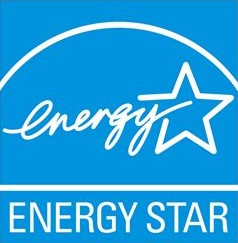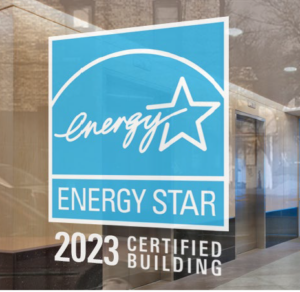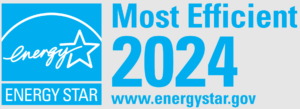We all recognize the Energy Star logo on refrigerators and other appliances. Since 1992, the U.S. Environmental Protection Agency has awarded the Energy Star rating to products that are determined to  be energy efficient in their class. What My Green Doctor readers may not know is that Energy Star is a great tool for the entire healthcare office to save energy and money.
be energy efficient in their class. What My Green Doctor readers may not know is that Energy Star is a great tool for the entire healthcare office to save energy and money.
In this blog, I explain how you can generate substantial savings for your business and your home with the combination of My Green Doctor as your practice management guide and the easy-to-use Energy Star Portfolio Manager to track and improve your energy use efficiency (1 & 2).
U.S. healthcare, the largest industry in the world’s largest economy, is highly energy inefficient. The work that we do in healthcare accounts for approximately 9% of America’s greenhouse gas emissions, or more than 550 million metric tons annually (2). This is nearly five times the annual emissions of the U.S. military. If the U.S. healthcare was its own country, it would rank 11th worldwide in greenhouse gas  pollution!
pollution!
Saving energy is also about saving lives. The burning of fossil fuels to generate electricity pollutes the air with particulate matter (PM2.5) and other air toxics that contribute to deaths from asthma, COPD, heart disease, and cancers. Healthcare’s use of fossil fuels is responsible for more than 400,000 years of life lost annually in the US alone (3). The harms are strikingly greater when you add together the health and economic losses. Economists name these combined costs as “social costs”(4). The healthcare industry’s social costs of its greenhouse gas emissions for 2020 amounted to between $255 billion and $3.3 trillion. To put this into perspective, total Medicare and Medicaid spending in 2022 was $1.75 trillion.
Healthcare practices, therefore, have a significant opportunity to improve population health by becoming more energy efficient. In 2022 the U.S. Environmental Protection Agency (EPA) published an Energy Star guide for healthcare titled, Energy Star Portfolio Manager For the Healthcare Sector that helps medical clinics, offices, and ambulatory surgical or diagnostic centers to track and reduce their energy use and commensurately greenhouse gas emissions. Portfolio Manager works whether the practice owns its building or rents. Healthcare practices can improve their energy efficiency to become “Energy Star Certified”, meaning that their energy efficiency falls within the top quartile within their peer group. Energy Star Certified buildings on average use 34% less energy than similar types of businesses. Unfortunately, in 2023 only 0.6% of hospitals and 0.3% of medical offices were Energy Star certified.
My Green Doctor and Energy Star Portfolio Manager work together to help get you to the front of the pack. My Green Doctor is a free practice management system that explains how to add five minutes of environmental sustainability topics – energy, water, purchasing, chemicals, recycling, food choices, transportation, and other others—to each monthly office or clinic staff meeting. Energy Star Portfolio Manager compliments My Green Doctor by quantitatively tracking your energy use and by offering more ways for you to save.
Your practice can use Portfolio Manager to track your energy use only if your clinic or office has its own electricity meter. If you do not have a meter, there is no benefit from registering but you can still use Portfolio Manager to identify ways to save energy and money (see below)
How to Get Started with Portfolio Manager
I will walk you through using Portfolio Manager. You can do this at your own pace and log out when you need to:
Step 1: Register your practice at https://www.energystar.gov/buildings/benchmark/portfolio-manager-login
Step 2: Add your property to the Portfolio Manager database. This will take five minutes. You will indicate the type of your practice (e.g. medical office, ambulatory surgical center (ASC), or hospital) and whether you are a renter or own the whole building. You can enter multiple sites if you are part of a large healthcare system.
Step 3: Enter information about your building. This will take about fifteen minutes. If you are in a city, you likely will be asked to enter a Standard Identification Number for your city and perhaps for your building; the website explains how to find these numbers. This will save you time later because Portfolio Manager will be able to automatically access your utility records. You will add some further information such as the square footage of your space. At this point, your building is entered and you’ll receive your practice’s Portfolio Manager Property Identification Number.
Step 4: Next, you will be taken to a page where you can enter your electricity meter information to make it easy for Portfolio Manager to track your progress: (https://portfoliomanager.energystar.gov/pm/property/meterSetup/33576020?execution=e3s1). This will take about thirty minutes to set up. You will enter any energy source you might be using, even  kerosene or wood if you burn those, but most medical offices will have their the utility company send their electricity use, and perhaps their natural gas and heating oil usage, directly to Portfolio Manager.
kerosene or wood if you burn those, but most medical offices will have their the utility company send their electricity use, and perhaps their natural gas and heating oil usage, directly to Portfolio Manager.
Your Energy Star data is held strictly confidential. Energy Star also allows users to track water use and waste. Energy Star comes with free optional training and technical support from the EPA. If you are designing a new office or facility, Energy Star offers a service called “Designed to Earn the Energy Star” that explains how to add wise energy use into the design and construction phases of your project (5).
Energy Star has saved commercial building owners and tenants $200 billion in energy costs and avoided 2.7 billion metric tons of greenhouse gas emissions since 1992. These savings over thirty years are five times the healthcare sector’s current annual emissions.
Using Portfolio Manager to Identify Savings and Get Energy Star Certified
Energy Star Portfolio Manager will generate your Energy Star Score, a benchmark with which to compare yourself to other similar medical buildings. Portfolio Manager provides numerous tools, case studies, online trainings, and opportunities to improve: https://www.energystar.gov/buildings/save-energy-commercial-buildings
The Environmental Protection Agency is concerned principally about three “Scopes” of greenhouse gas emissions. “Scopes” is a concept that everyone in healthcare is going to read a lot about over the next few years. Scope 1 emissions result from the burning of fuel onsite, such as a stove or hot water heater in your office burning natural gas (largely methane). Scope 2 emissions are produced by your utility company burning fossil fuels (coal, natural gas, diesel) to make the electricity you buy. Scope 3 emissions are due to the products you buy, such as paper towels, gowns, cleaning products and computers. Scope 3 greenhouse gas emissions involve the energy it takes to manufacture something, package it, transport it, and dispose of it. Scope 3 emissions can be as much as 80% of the emissions from some types of practices. Portfolio Manager will allow you to submit Scope 3 information but there is not reliable Scope 3 data available for most of the products we buy. For this reason, the Energy Star certificate only takes into account your Scope 1 and Scope 2 data.
company burning fossil fuels (coal, natural gas, diesel) to make the electricity you buy. Scope 3 emissions are due to the products you buy, such as paper towels, gowns, cleaning products and computers. Scope 3 greenhouse gas emissions involve the energy it takes to manufacture something, package it, transport it, and dispose of it. Scope 3 emissions can be as much as 80% of the emissions from some types of practices. Portfolio Manager will allow you to submit Scope 3 information but there is not reliable Scope 3 data available for most of the products we buy. For this reason, the Energy Star certificate only takes into account your Scope 1 and Scope 2 data.
“Just 0.3% of U.S. medical offices were Energy Star certified as of 2023”
The 2022 Federal Inflation Reduction Act that offers tax credits that make investments in energy efficiency and renewable energy substantially more affordable. These are available equally to for-profit companies, non-profit clinics, and to private homeowners. With little or no capital expenditures, stand-alone practices and large clinic buildings can install solar panels, backup battery storage, electric vehicle charging stations, and many other products that will generate savings for your business, your staff, and your own family. If you have a suitable roof, now is the time to call your local solar installer to get a quote, and to speak as well with your accountant and perhaps your banker.
“If you have a suitable roof, now is the time to call your local solar installer.”
Healthcare delivery should not harm those we seek to treat or cure. Our business model need not present a moral hazard. The Energy Star Portfolio Manager For the Healthcare Sector tracks your energy use quantitatively, identifies energy inefficiencies, and suggests prudent investments in energy efficiency. In one EPA study, commercial buildings with a below average Energy Score when they first signed up saved 5% annually on their energy bills over a four-year period by making fairly easy improvements. Register at Energy Portfolio and My Green Doctor to put these to work for you today.
Resources & Links
- Environmental sustainability healthcare practice management: https://www.MyGreenDoctor.org or https://www.MyGreenDoctor.es (en espanol)
- Portfolio Manager to track energy use by health care practices: https://www.energystar.gov/buildings/tools-and-resources/using-energy-star-portfolio-manager-track-energy-use-and-ghg/ Accessed 3.31.24
- Lives lost due to healthcare industry air pollution: Eckelman MJ, Sherman J (2016) “Environmental Impacts of the U.S. Health Care, System and Effects on Public Health Care”. PLoS ONE 11 (6): e0157014. doi:10.1371/journal.pone.0157014
- Social costs of healthcare: https://www.healthaffairs.org/doi/epdf/10.1377/hlthaff.2020.01247/ Accessed 3.28.24
- Energy Star’s resource for planners & architects: https://www.energystar.gov/buildings/building-recognition/designed-earn-energy-star
- Energy Star’s Portfolio Manager energy tracking for single family homes: https://www.energystar.gov/buildings/tools-and-resources/energy-star-score-single-family-homes-united-states/
The Author
 David Introcaso, Ph.D., is an independent health care policy consultant specializing in climate crisis-related health care policy reform. He has conducted environmental and health care policy research for the U.S. Congress and the Department of Health and Human Services. He also is the creator and host of The Healthcare Policy Podcast. His email address is [email protected].
David Introcaso, Ph.D., is an independent health care policy consultant specializing in climate crisis-related health care policy reform. He has conducted environmental and health care policy research for the U.S. Congress and the Department of Health and Human Services. He also is the creator and host of The Healthcare Policy Podcast. His email address is [email protected].
Keywords: medical practice, environmental sustainability, energy efficiency, Energy Star, ACA

